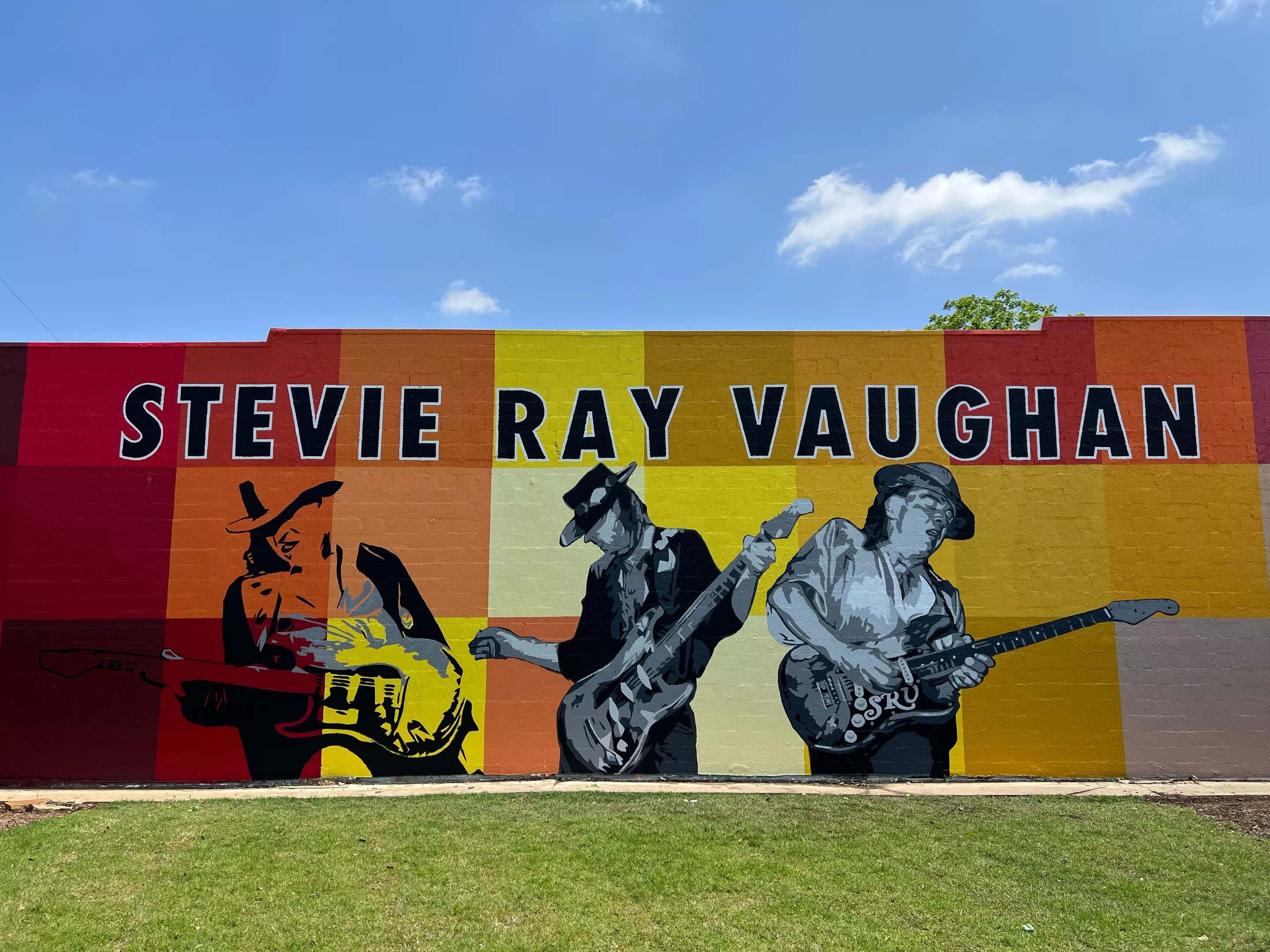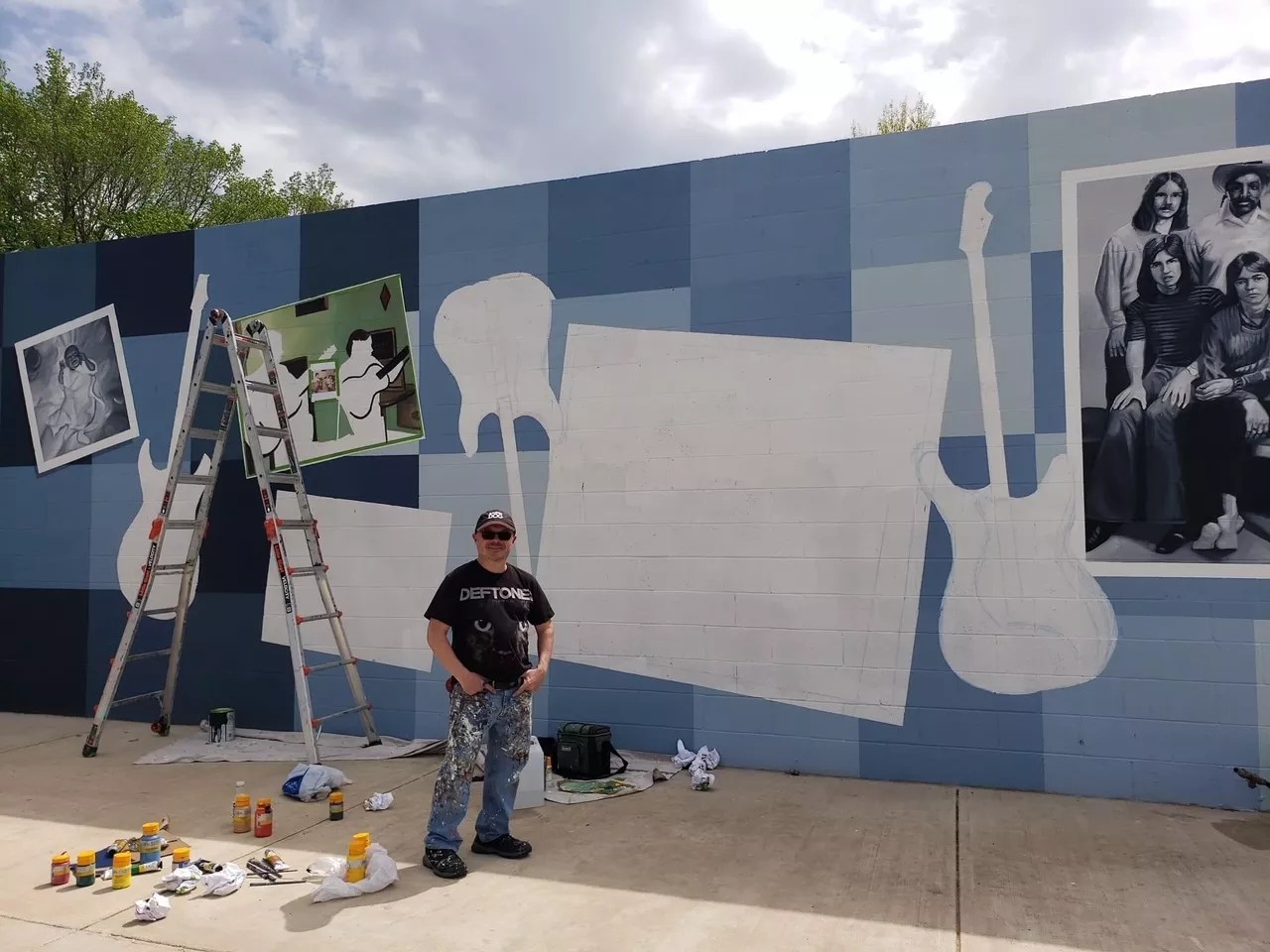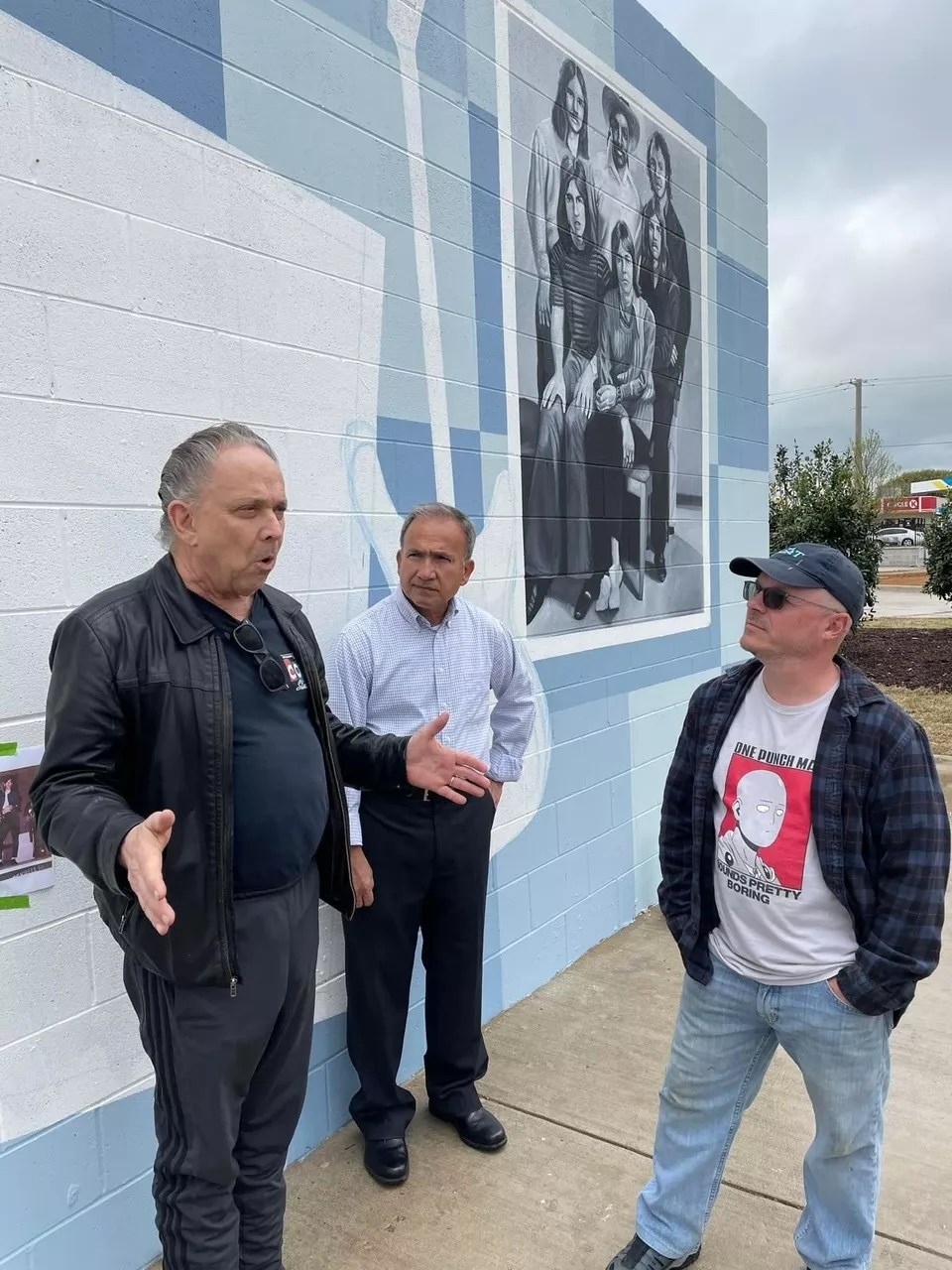
Mischelle Hunter

Audio By Carbonatix
Stevie Ray Vaughan wasn’t much older than the South Park gang when he first appeared on stage with his older brother Jimmie at the Cockrell Hill Jubilee. The 1965 celebration took place at the Hill Theater in Cockrell Hill, a small community surrounded by Oak Cliff and just down the road from the house where the Vaughan brothers lived. In a photograph of their first performance, Stevie Ray and Jimmie are seen dressed in their Sunday best, preparing to unleash their axes on the crowd, many of whom would remember them nearly 60 years later.
That old photograph of their first performance with the Swinging Pendulums appears as part of a new mural dedicated to the Texas guitar blues legends.
Now, Jimmie Vaughan stands in front of the mural, recalling those formative years with his little brother. His hair has long since gone from black to gray. He still wears it in the same ducktail style immortalized in The Outsiders, a 1983 movie about the chasm that divides the rich and the poor and the outsiders who dwell there.
The Vaughan brothers crossed that divide a few years after their first performance. They dropped out of high school and headed to Austin to pursue the limelight that brought them fame, fortune and heartache. And while Jimmie Vaughan had earned recognition for his talent on stage, Stevie Ray Vaughan’s legacy was immortalized after his death in 1990. He was only 35.
This year, make your gift count –
Invest in local news that matters.
Our work is funded by readers like you who make voluntary gifts because they value our work and want to see it continue. Make a contribution today to help us reach our $30,000 goal!
Several photographs capture the Vaughan brothers’ formative years in the new mural at Stevie Ray Vaughan Park in Cockrell Hill. The city built an event center where the Hill Theater once stood and erected a masonry wall where the mural by Dallas muralist Steve Hunter now appears.
At the corner of Cockrell Hill Road and Jefferson Boulevard, Stevie Ray Vaughan Park is a place where food trucks will set up and local music will unfold on a small stage. In late May, the community will gather for the first Movie in the Park night.
But on this Sunday in late April, Jimmie Vaughan was on memory road at his brother’s park. He’d been traveling it all weekend. He had attended the opening night of Buddy magazine icon Kirby Warnock’s new documentary Jimmie and Stevie Ray Vaughan: Brothers in Blues the night before at the Texas Theater. It was a family affair, a sold-out show with audience members who Warnock said all had some kind of connection to the Vaughan brothers over the years.

Steve Hunter in front of his mural honoring Jimmie and Stevie Ray Vaughan.
Mischelle Hunter
An encore presentation of Warnock’s documentary will screen at 7 p.m. on May 14, at the Texas Theater. It’s being hosted in conjunction with the Dallas International Guitar Show, which took place in early May.
“In the words of Lou Ann Barton, ‘They came from nowhere and went everywhere,'” Warnock said in the opening to the documentary.
Warnock’s 2013 documentary When Dallas Rocked planted the seed for Stevie Ray Vaughan Park in Cockrell Hill. City administrator Bret Haney had just returned from a council meeting in 2014 when he saw Warnock’s documentary on PBS and learned about the Vaughan brothers’ connection to Cockrell Hill.
“I said, ‘Holy Moly,’ and picked up the phone and called the mayor and picked up the book the next day,” Haney says.
Haney picked up Craig Hopkins’ book Stevie Ray Vaughan: Day by Day, Night after Night. Inside, he discovered old photographs of the Vaughan brothers that would later appear as part of the mural at Stevie Ray Vaughan Park.
About a year later, the city discovered that the property where the Hill Theater once stood had been foreclosed. Haney says the city bought the property for about $80,000 and began moving forward with plans to build a park in honor of Stevie Ray Vaughan.
“If you talk to the mayor, he’ll say the stars aligned for this project,” Haney says.
Cockrell Hill Mayor Luis Carrera was there with Jimmie Vaughan when he arrived on a Sunday in late April to view the new mural at the park. Carrera had been planning the park for several years and spent nearly a year working on it with his son, who is a landscape architect.
He’d gotten the inspiration to honor the Vaughan brothers after he watched When Dallas Rocked. His takeaway from it, he said, was that the cities where the Vaughan brothers grew up needed to do more to recognize their musical contributions.
Aerosmith’s Joe Perry has called Stevie Ray Vaughan one of the greatest and most influential guitar players ever. In a 1996 tribute, blues guitar legend B.B. King praised Vaughan and compared their playing styles.
“When I play, I play sort of like talking, you know, syllables, you say a sentence here, a sentence there and then, I have to stop and think for something else to keep my conversation going,” King said. “But his didn’t seem to be that at all. It was fluent. [Stevie Ray] flowed when he played. He could get something going and it was like a song and it would just go on and on. Ideas continuously flowed, I don’t have that. There is not a lot of people that I hear that have that but Stevie had it.”
Jimmie Vaughan is also a blues guitar powerhouse on stage. Some of his influences include the Three Kings of Blues – Albert King, B.B. King and Freddie King – and Johnny “Guitar” Watson. Like his little brother, he’s also shared the stage with blues legends such as W.C. Clark (known as the Godfather of Austin Blues), Eric Clapton and Robert Cray. In the 1970s, he formed The Fabulous Thunderbirds and stayed with them until 1990 when Stevie Ray died in a helicopter crash. Following Stevie Ray’s death, he released his first solo album Strange Pleasure in 1994 and continued pursuing a solo career that had him recently returning to the stage, Warnock says, while recovering from heart surgery.
The Vaughan brothers’ music journey led to recognition from the Grammy Awards and from Dallas in a memorial public art display at Kiest Park. Warnock had led the charge with other fans as part of the fund-raising Vaughan Brothers Art Project. They raised more than $16,000 for the art display and received $74,000 that had been allotted from the 2006 bond election to create a future monument in honor of Stevie Ray.
At the time, Cockrell Hill had purchased the old Hill Theater property. Carrera said he called then-Dallas Mayor Mike Rawlings, explained their plans for the Stevie Ray Vaughan Park and asked if Rawlings wanted to make it a joint venture between the two cities because they both have a historical connection to the Vaughan brothers. Rawlings, Carrera said, politely declined since they were already in the middle of the Kiest Park project.
The stars aligning for Cockrell Hill continued a few years later when Warnock began working on the Vaughan brothers’ documentary. He emptied his 401-K retirement to fund it and still had to accept financial help from friends, whom he listed as executive producers, to make it a reality.
“When you talk about Stevie, everybody has a different viewpoint depending on when they knew them,” Warnock says. “I was there watching all of this as a journalist, a paid observer and got to go backstage at every show because I was at Buddy and had a vantage point that not a lot of people have. How many people do you know at age 14 drop out of the ninth grade and become a professional musician and actually made it? I don’t know anyone except for them.”

Jimmie Vaughan, left, visits the mural with Cockrell Hill Mayor Luis Carrera, center, and muralist Steve Hunter.
Mischelle Hunter
It happened, Warnock points out, in a time when people couldn’t be Instagram influencers. There was no Facebook or Tiktok. They had to set up a mic, a guitar and an amp and hope to draw people by word of mouth.
Warnock says he felt a sense of urgency to tell their story because everyone who knew the Vaughan brothers was getting older and knocking on heaven’s door. He began tracking down family and friends of the Vaughan brothers, people with first-hand accounts. He flew to Los Angeles and interviewed Eric Clapton, who discussed Stevie Ray’s final performance in 1990. He spoke with music legends Billy Gibbons from ZZ Top and Jackson Browne, who offered his studio to Stevie Ray, resulting in “Texas Flood.” David Bowie’s producer Nile Rodgers recalled Bowie’s friendship with Stevie Ray.
Then Warnock spent a few more years trying to get the music rights for the nearly two dozen songs that appear on film. He said it wasn’t cheap or easy, especially since some of the copyrights were held by more than one entity.
Before releasing the documentary in late March, Warnock put together a rough cut and showed it to Jimmie Vaughan at his home in Austin. After it was over, he recalled Jimmie looking at him and saying, “I don’t know whether to cry or kiss you.”
In late April, Carrera wasn’t sure if Jimmie wanted to hug him or punch him. He said that he felt like he was walking on eggshells around the Texas guitar legend. At first, he thought Jimmie was in a bad mood until he cracked a smile.
Jimmie apologized for not attending the park’s grand opening or inviting Carrera to attend Warnock’s Saturday night screening at Texas Theater. He even offered to come back for free and play a show for residents at the new city park.
Carrera began discussing the inspiration behind the mural and the old photographs of the Vaughan brothers that Dallas muralist Steve Hunter had captured perfectly in his art.
Hunter’s art affair with Stevie Ray Vaughan began shortly after his arrival from Scotland. Texas blues wasn’t big there, Hunter says, but when he returned to Texas in the early 2000s to teach art in Oak Cliff, students’ parents began sharing stories about Stevie Ray, who had grown up in the area.
Over the years, Hunter has painted a few Stevie Ray murals, including at Dots on Commerce, another at the Deep Ellum Art Company and one on the side of the restaurant Stirr at the intersection of Crowdus and Main streets in Deep Ellum.
In early January, Hunter received a call from Carrera, who told him about the park. Hunter listened to Carrera and Haney discuss the Vaughan brothers’ story. He said he knew quite a lot about the Vaughan brothers but wasn’t familiar with their first performance at the Cockrell Hill Jubilee in the 1960s.
Hunter came up with the idea to paint the mural as a timeline that chronicled the Vaughan brothers’ formative years in Dallas until they left and went on to fame. He saw it as an educational opportunity for people. As he painted the mural, locals would drop by and share their stories about the Vaughan brothers.
Though the park was called the Stevie Ray Vaughan Park, Hunter had other ideas for the mural. “I wanted to include his brother Jimmie,” he says. “He is overshadowed by Stevie, but Jimmie is still playing and he’s a great musician.”
About four months later, Jimmie Vaughan appeared in front of Hunter’s mural at Stevie Ray Vaughan Park, no doubt thinking about his time on stage with his little brother. After leaving the Fabulous Thunderbirds in 1990, Jimmie recorded his first and only duo album with his little brother. They called it Family Style. Stevie Ray died before they could release it.
Carrera stood next to him, discussing the photographs that Hunter captured in the mural. He had to get permission from Jimmie to use Stevie Ray’s name since Jimmie is in charge of the estate. He was doing his best to reassure him that they were honoring both of them with the park and the mural, despite only naming it after his little brother.
Jimmie motioned toward the photo of Stevie Ray and himself on stage in 1965 at the Cockrell Hill Jubilee.
“Yeah, well, actually that was my band and that was my guitar, and my mother told me that I better get him on the stage that day,” Jimmie said.